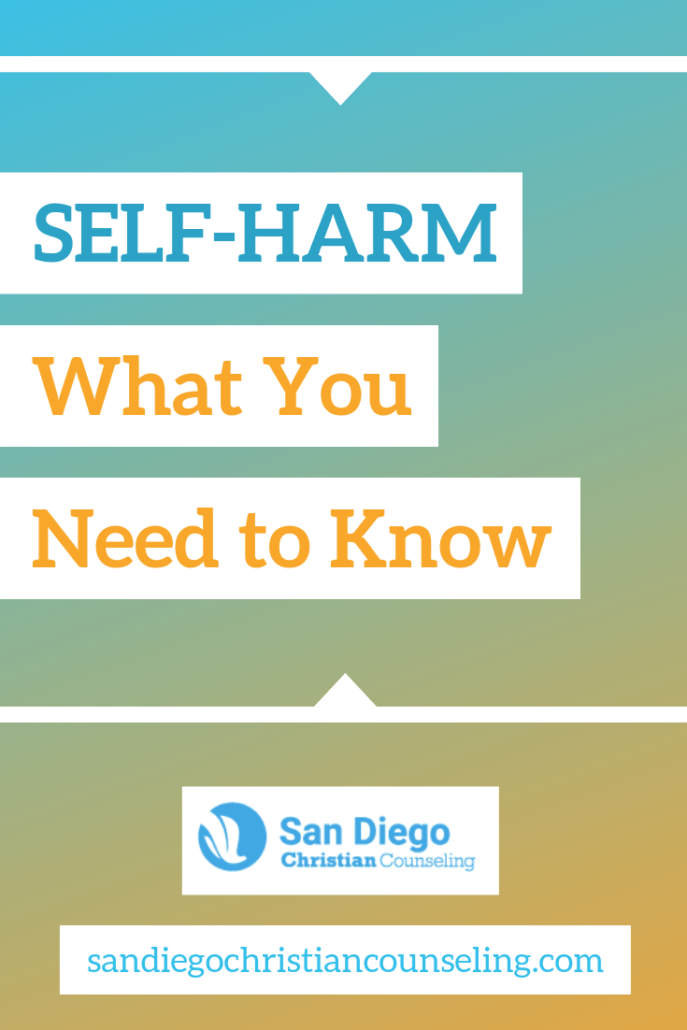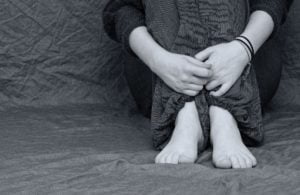If you have never participated in a form of self-injurious behavior, it can be confusing when you hear about someone cutting themselves. You might ask, “Why would someone have the desire to intentionally hurt themselves?” What you may not be aware of is that for some, self-harm can genuinely feel pleasurable.
 As an example, young children hit their heads on walls when angry or overwhelmed. You may have witnessed this yourself with your own kids or a friend’s children. The initial pain sends a wave of “feel good” chemicals through the body. The child alleviates the pain through hitting their head on a surface. This behavior can be scary, but it’s typical in children up to four years old.
As an example, young children hit their heads on walls when angry or overwhelmed. You may have witnessed this yourself with your own kids or a friend’s children. The initial pain sends a wave of “feel good” chemicals through the body. The child alleviates the pain through hitting their head on a surface. This behavior can be scary, but it’s typical in children up to four years old.
Teenagers might scratch themselves to escape their feelings of anger or frustration. This action is then tied to those “feel good” emotions and is also a way to punish themselves. It’s important to watch for signs of self-mutilation in adolescents and provide solutions to help them cope with the thoughts or emotions they are battling. There could be a variety of reasons why someone might resort to self-injurious behavior.
A Story about Self-Harm
As a young child, Maria would slam her head against the table or wall when frustrated. Maria’s mother’s first child never did this, so she was confused as to what caused Maria to lash out. She researched the reasons and decided to wait it out.
As Maria became a preteen, she continued to bang her head on the wall in her moments of rage. Over time, Maria learned to turn to karate as a way to release those unwelcome emotions. Maria’s mother was excited to see her daughter’s progress and that she had stopped banging her head on the wall.
One day, Maria’s mom entered Maria’s room to look for dirty laundry. Months had passed since she last entered Maria’s room. Maria’s mother was horrified to see Maria has stabbed her headboard repeatedly with a knife.
Instead of exploding, Maria’s mother ignored the issue and continued to keep an eye on Maria. In time, she quit her destructive patterns and became a thriving, productive woman in the world. Although she has times of frustration, she no longer escapes her feelings by destroying something.

How to React to Self-Harm Issues
If your child is banging their head or scratching, overreacting isn’t always the wisest way to solve the problem.
- A kid may increase their head banging if they sense it’s the only way to get noticed.
- Overreacting might terrify the child and cause more issues.
Respond in a relaxed, casual tone that can help put your child at ease - Encourage the child to discuss their emotions and thoughts
- Remind them you are always available to approach instead of resorting to self-infliction.
- Research some options for enhancing self-confidence.
- Come up with a plan on how to cope, along with practicing communication skills.
 Your child may prefer to talk about their actions more than the reason why they are upset. Your child may not even understand what’s causing their anxiety. In cases like these, therapy is an excellent option. A therapist is professionally trained to uncover the root issues.
Your child may prefer to talk about their actions more than the reason why they are upset. Your child may not even understand what’s causing their anxiety. In cases like these, therapy is an excellent option. A therapist is professionally trained to uncover the root issues.
When a person performs an act of self-injury, immediate relief of pressure from “bad feelings” occurs. Naturally, these feelings are fleeting and are normally replaced by feelings or thoughts of condemnation. This is the vicious cycle of self-injurious behavior.
Children are increasingly exposed to self-injury more than years ago. As a result, self-infliction has become common in children as young as 11.
Once self-harm starts, it can be difficult to quit as the momentary “high” becomes addicting. That’s why it can take awareness, accountability, and support from a counselor to break the cycle of self-injury. Ultimately, the person has to want to stop causing harm to themselves.
An Example of Self-Injurious Behavior
Jacob had a habit of biting his cheek when he felt the urge to get upset and raise his voice. It would help calm him down and keep him composed. However, by the age of 13, the number of situations that set him off had escalated. Anytime he faced his rude brothers, angry father or school bullies he would bite down on his cheek. This caused him both pain and relief. The pain reminded him he was real.
Jacob was experiencing depression, but it was difficult for him to define it as depression since this was the norm for his life.
As situations and stress became more severe, Jacob began scratching himself until his skin was red and raw. Jacob would replay hurtful experiences in his mind and his scratching became more intense. He wished his family would care about him and express concern.
At school, he excelled in his studies and teachers were shocked to learn about his problem with coping. In his health class, self-harm was discussed. He couldn’t help but imagine what it must be like. As he poked his skin with a pin, it didn’t cause much pain. He became enthralled with watching the blood well up. Seeing the blood drip from his skin released the anger inside. He began to cut with blades to cope with his pain.
Jacob went to college where he had more freedom and responsibility. His need to see perfect grades created severe anxiety. Cutting was his only answer to the looming anxiety he felt.
Jacob met a girl on campus, fell in love and his depression seemed to fade, momentarily.
Unfortunately, positive thinking or love can’t remove depression completely. Jacob learned cutting himself did not help him relate emotionally and socially with his girlfriend. She broke up with him and he fell back into old patterns.
 Overcome by shame, Jacob recognized his life had become unmanageable and he needed help. Although he had been to therapy before at his parents’ request, this time he walked through the doors on his own. He wanted to become well and learn why he couldn’t stop his destructive behavior.
Overcome by shame, Jacob recognized his life had become unmanageable and he needed help. Although he had been to therapy before at his parents’ request, this time he walked through the doors on his own. He wanted to become well and learn why he couldn’t stop his destructive behavior.
Jacob allows himself to express emotions today and to dig deep into what is bothering him. He still occasionally bites his cheek, but he has eliminated cutting from his coping mechanisms. He knows how to vocalize when life becomes overwhelming for him. Jacob has learned what people and situations to try to avoid, so he isn’t triggered unnecessarily. Counseling has provided him with a safe place to share his feelings about his life experiences.
Forms of Self-Harm
Self-harm is normally done in private and in a controlled, planned manner.
Examples of self-injurious behavior include:
- Cutting the skin
- Scratching
- Burning (with matches, cigarettes or even ice)
- Carving words or designs on the skin
- Hitting or punching
- Piercing the skin
- Pulling out hair
- Persistently picking at a wound as it heals
The most common forms of self-harm are cutting which makes up 70% to 90% of all cases. Hitting oneself or banging the head happens in 21% to 44% of self-harm cases.
Reasons for self-injurious behavior:
- Boredom
- Feelings of euphoria
- To calm down
- Numbing of emotions
- Addictive
- A feeling of empowerment or control
- To fit in with peers
- To inflict punishment
- To communicate in a nonverbal form
- Fill an empty void
- Lonely or misunderstood
- Low self-esteem or depression
- Inability to regulate emotions
- Feel panic or frustration
- A reminder of being alive
Many teenagers use social media to glorify cutting. Young, impressionable people can be drawn to these websites and social profiles. Cutting is portrayed as cool and encouraged. They share stories and display their scars from cutting. Glorifying self-harm is an indicator of a person’s state of mind. It’s important for parents to know what their kids are consuming online and who they are hanging around.
How Common is Self-Harm?
Self-harm is rare, despite how often certain communities and television shows are glorifying it. It is higher among teenagers, but most grow out of the self-harm habit. Still for the 17% to 35% who do practice self-harm getting professional help is an incredibly beneficial way to learn how to handle life’s challenges.
Self-Harm Risk Factors
Age
Teenagers are more likely to engage in self-harm. Parents need to be aware and active in their child’s life to notice if she is inflicting intentional wounds on herself.
Having Friends Who Self-Harm
 Once I heard a story of a child who cut herself because her friend did and she didn’t want her to do it alone. The child didn’t even know the implications of cutting. Children are easily swayed and if cutting is acceptable in their circle of friends it could become normal for the child. Children don’t want to be left out or feel like an outsider.
Once I heard a story of a child who cut herself because her friend did and she didn’t want her to do it alone. The child didn’t even know the implications of cutting. Children are easily swayed and if cutting is acceptable in their circle of friends it could become normal for the child. Children don’t want to be left out or feel like an outsider.
Life Issues
If a person is isolated or ostracized, he might consider self-harm as a coping mechanism. A person’s mental state can be dramatically influenced by the toxic or unhealthy environment.
Mental Health Issues
A person battling depression, or another mental health issue like bipolar disorder, has a higher probability of turning to self-harm practices.
How to Diagnose Self-Injurious Behavior
Because self-harm is often hidden, it isn’t obvious until revealed. Now, the level of severity is something a doctor or therapist would need to determine. If someone has many tattoos or body piercing that doesn’t necessarily signify self-harm, but it can be a part of the behavior expressed by a cutter.
Substance Abuse
Alcohol and drugs alter the brain and significantly increase the risk of those prone to self-harm.
Self-Harm and Suicide
Self-harm is normally done in private and the scars are hidden under long sleeves. It doesn’t automatically mean someone is suicidal. However, if the person is depressed or battling other overwhelming emotions, it could be a way to gain confidence to commit suicide. Sometimes the person cuts too deep and accidentally commits suicide or ends up in the hospital.
If you, or someone you know, is contemplating ending their life please reach out to the National Suicide Prevention Lifeline at 1-800-273-8255. Someone is waiting to speak with you 24/7.
Self-Harm Complications
Even after someone quits inflicting wounds on themselves, the scars are usually still evident. This can be a source of shame for the person. Also, infections can occur as a result of creating open wounds using random objects. Accidental death can happen if the person uses extremely sharp objects. It’s important to lovingly talk to your friend about self-harm if you notice any signs. Let them know that they are seen and heard.
If you are recovering from self-injurious behavior or need someone to talk to, please reach out to a counselor you can trust to help you navigate your experiences.
“Boy Fashion Model”, Courtesy of Pexels, Pixabay.com, CC0 License; “Harmony Rocks”, Courteys of Devanath, Pixabay.com, CC0 License; “Desperate” Courtesy of Anemone123, Pixabay.com, CC0 License; “Teen in Cafe”, Courtesy of Nastya_gepp, Pixabay.com, CC0 License


